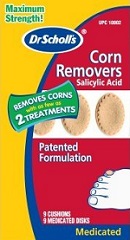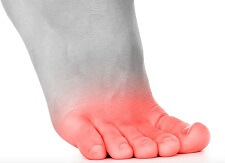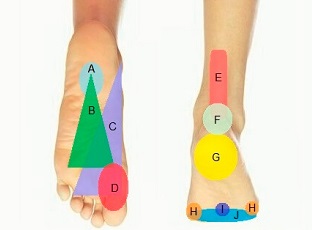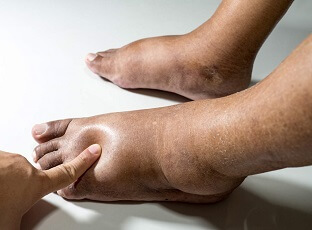- Home
- Common Foot Problems
- Corns & Calluses
Foot Corns & Calluses
Written By: Chloe Wilson BSc(Hons) Physiotherapy
Reviewed By: FPE Medical Review Board
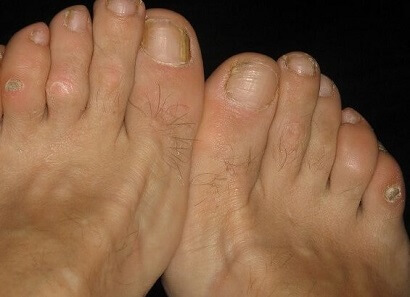
Foot corns and calluses are small areas of thick, raised, hardened skin that cause pain.
They develop when there is excessive friction or pressure on the skin, usually from ill-fitting shoes or from lots of walking.
Foot corns are also known as "Heloma" or "Clavus", and calluses are also known as "tyloma" or "hyperkeratosis".
Corns and calluses are generally not a serious problem and can be easily treated with a combination of good foot hygiene, medication and orthotics. However occasionally they become infected or cause ulcers in which case surgery may be necessary.
Here we will look at the different types of foot corns and calluses, the common causes, best treatments options and how to prevent them from coming back again.
What Are Foot Calluses?
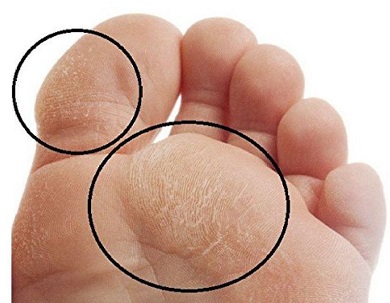
Calluses are areas of thickened, hardened skin, which are usually painless.
When the skin is exposed to excessive friction or pressure, it lays down extra layers to try and protect itself – a callus.
A callus can cover a large area but it is usually painless. People often develop more than one callus at a time.
Foot calluses generally appear on the sole of the foot (underneath part) particularly around the toes as lots of your weight goes through these parts when you walk.
What Are Foot Corns?
Foot corns tend to be smaller, more defined and are circular in shape than calluses. They are usually yellow/white in colour and have a transparent plug in the centre. Corns press into deeper layers of skin which causes damage and can make them very painful. In severe cases, foot corns can cause ulceration.
Corns on feet tend to develop either on the top, at the side or in-between toes. There are two main types of foot corns:
1. Hard Foot Corns
Hard corns are the most common type of foot corn. They are small, pale or yellow areas of raised, hardened skin, approximately pea-sized surrounded by a wider area of thickened skin.
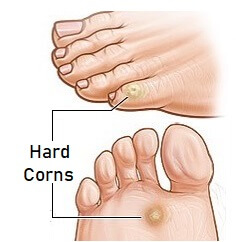
Hard corns on feet, aka Heloma Durum, tend to occur over bony areas such as on:
- Top of the toes - usually the outer ones
- Side of the little toe
- Ball of the foot
In most cases, hard corns develop due to friction from shoes.
2. Soft Foot Corns
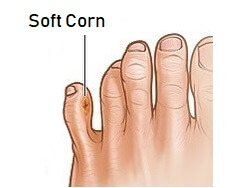
Soft corns, aka Heloma Molle, look different being white and rubbery. They are usually indented in the middle.
These foot corns are softened by moisture, usually from sweat or from not drying your feet properly. They tend to occur in-between the toes, usually the fourth and fifth toe when the toes rub against each other.
Causes of Corns & Calluses
Calluses and corns on feet develop due to constant or repetitive pressure and friction on the skin. The most common causes of foot corns and calluses are:
- Ill-fitting Footwear: if your shoes are too tight, or if you frequently wear high-heels, particularly ones with a narrow toe box, the toes get squashed which can lead to the formation of foot corns or calluses
- Altered Foot Shape: Foot deformities such as hammer toe, mallet toe, claw toe and bunions make your bones more prominent and therefore more prone to friction resulting in heloma formation
- Being On Your Feet: If you are standing for long periods, run frequently or walk barefoot, you are more likely to develop foot corns and calluses
- Aging: as we age, our skin gets thinner with less fatty tissue so there is less padding on the soles of our feet, making corns and calluses more likely to develop
- Gender: Helomas are more common in women than men
How Are They Diagnosed?
Your doctor can normally diagnose calluses and foot corns by asking about your lifestyle and looking at your feet and footwear.
They may want to do X-rays if they suspect there may be an underlying problem with the bone which is causing your corns on feet. Occasionally, they may perform a biopsy if there is a significant foot lump.
There are some other conditions that can cause lumps on the feet that are similar to foot corns and calluses such as ganglion cysts and fibromas - you can find out more about these and how to tell which one you have in the foot lumps section.
Corns are often confused with plantar warts. Whilst similar in appearance, there are subtle differences. Corns are small, yellow, circular areas of raised skin caused by friction whereas plantar warts contain small black dots and are caused by an infection. Plantar warts are highly contagious and easily spread whereas corns are not.
#CommissionEarned from Amazon on qualifying purchases
Treatment For Corns & Calluses
Treatment for foot corns and calluses aims to alleviate the symptoms and to cure the underlying cause to prevent them from coming back again. Typical callus and foot corn treatment consists of:
1. Pumice Stone
A great place to start when treating foot calluses and corns is with a pumice stone. You can gradually, gently rub away areas of hardened skin with the foot corn or callus using a pumice stone to get rid of any foot lumps. It helps to soak the foot for about 15-20 minutes first to soften the skin.
2. Foot Files
For more stubborn foot corns and calluses, you might need something a bit more serious than a pumice stone. There are lots of different foot files and scrapers on the market, often sold in sets which can be extremely effective at removing areas of thickened skin on the foot. They are often sold in sets containing a range of filing products for corn and callus removal.
3. Footwear
There should be adequate space in your shoes to prevent friction and foot corn or callus formation.
Ideally, shoes should have a rounded, wide toe box, have a soft top, be one centimeter longer than your longest toe and be flat (less than 4cm heel). If you have foot abnormalities, your podiatrist can advise you about specially designed shoes.
4. Shoe Inserts
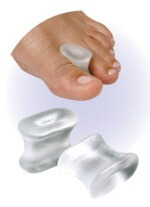
Orthotics can be a really useful treatment with foot corns and calluses. Foam wedges and toe spacers can help to prevent foot corns developing between your toes, and soft insoles reduce pressure on the bottom of the foot. A podiatrist will be able to advise you what products would best suit you.
Visit the Toe Separators section to find out how they can help reduce corns and calluses as well as to see user reviews.
5. Creams
You can get special creams designed to rehydrate areas of thick, dry skin which can be particularly useful for treating foot calluses. Lanolin is one of the most effective with user ratings of 4.7/5.
6. Trimming
A podiatrist can use a scalpel to remove your foot corns or callus, known as trimming or pairing down. This should only ever be carried out by a trained professional. It is a painless procedure and people usually feel instant relief. The procedure may need to be repeated if the corn or callus returns.
7. Chemicals
There are various different chemicals that can help to effectively treat foot corns and calluses.
Your doctor or podiatrist may apply a special form of salicylic acid which breaks down the hard skin, softening your foot corn. The skin becomes white and you can then trim or peel away the dead skin so the foot corn no longer sticks out.
Salicylic acid comes in different forms such as plasters, drops and pads and can be bought from a pharmacy but care should be taken when applying as they can burn healthy tissue. Only use them if directed by your doctor/podiatrist, and never use them if you suffer from diabetes or poor circulation as there is a risk of ulcer formation.
Check out these popular corn treatments and what people say about them.
8. Antibiotics
Occasionally the skin around corns on feet can become infected in which case it will be red and sore. This can be cleared up with a course of antibiotics, prescribed by your doctor.
9. Surgery
If you get recurrent helomas due to a foot abnormality such as bunions, your doctor may recommend surgery to correct the bony deformity. Find Out More >
Recovery Process
Foot corns can take anywhere from a few weeks to several months to heal, depending on the severity of the condition. Foot calluses typically take several weeks to fully heal.
To speed up recovery, it's important to reduce the pressure and friction on the area. This may involve avoiding certain activities that cause irritation or wearing some kind of protective padding.
You should also regularly clean the area, rub off areas of dead skin with a foot file and keep it moisturized. Additionally, soaking your feet in warm water with Epsom Salt can help reduce inflammation and soften the skin.
Preventing Foot Corns & Calluses
Foot corns and calluses often return if the cause of them is not properly addressed. There are a number of things you can do to prevent foot calluses and corns developing or coming back:
- Keep Feet Clean: Wash your feet daily and always dry thoroughly in between your toes
- Moisturise: Apply moisturiser to your heels and the ball of your foot, but don’t apply it in between your toes
- Lose Excess Weight: Reduces the pressure going through your feet
- Pumice Stone: Use a pumice stone regularly to remove heloma areas of thickened skin
- Wear Clean Socks: Change your socks daily and air your feet at night to stop feet becoming sweaty
- Regular Foot Checks: If you are elderly or suffer from Diabetes, you should get your feet checked regularly by a specialist as you are more prone to developing foot problems
- Wear Good-Fitting Shoes: Shoes shoe be round toed, low heeled, supportive and soft. Feet tend to swell slightly during the day, so try to buy new footwear in the afternoon
- Use Toe Stretchers: Toe stretchers are specially designed socks or gel inserts that help stretch the muscle and ligaments around the toes improving the natural shape of the feet. This can really help to reduce the occurrence of foot corns
What Else Can Help?
Foot corns and calluses are a common problem but usually settle down within a few weeks with the correct treatment. The earlier you start treatment, the quicker you are likely to recover and it is really important to look after your feet to make sure they don't come back.
Foot corns and calluses are just one possible cause of pain and lumps in the foot. Visit the toe pain or foot lumps sections to find out more about other problems that can affect the toes.
You may also be interested in the following articles:
- Pain On Top Of Foot
- Foot Arch Pain
- Nerve Pain In The Foot
- Foot & Ankle Stretches
- Swollen Feet & Ankles
- Foot Numbness
Related Articles
Page Last Updated: 20th November, 2024
Next Review Due: 20th November, 2026
